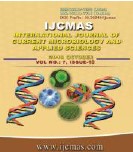


 National Academy of Agricultural Sciences (NAAS)
National Academy of Agricultural Sciences (NAAS)

|
PRINT ISSN : 2319-7692
Online ISSN : 2319-7706 Issues : 12 per year Publisher : Excellent Publishers Email : editorijcmas@gmail.com / submit@ijcmas.com Editor-in-chief: Dr.M.Prakash Index Copernicus ICV 2018: 95.39 NAAS RATING 2020: 5.38 |
An investigation was carried out to study the effect of intercropping crops (knol khol and broad bean) on growth, physiological aspects and yield of Cabbage. Sole crop of Cabbage was grown and between the inter-row spaces knol khol/broad bean was intercropped in single/double row planting. Spacing of 60 x 30 cm between cabbage and 30 x 30 cm for knol khol and 30 x 20 cm for broad bean was adopted. Growth parameters were recorded for cabbage as sole crop and as intercropped with single/double row of knol khol / broad bean. Maximum fresh weight (376.80 g) and dry weight (45.10 g) of the plant were observed in cabbage as sole cropping at 75 DAT which is at par with cabbage intercropped with single row of broad bean with fresh weight (344.13 g) and dry weight (41.56 g). However, on complete analysis of the physiological parameters, it can be concluded that cabbage sole cropping, recorded highest harvest index (64%), net assimilation rate (0.0344 g m-2day-1), plant growth efficiency (30.30%), crop growth rate (2.08 g cm-2 day-1), relative growth rate (0.0306 g g-1day-1) except leaf area index in which cabbage intercropped with single row of broad bean (1.16), exhibited maximum. Superiority in physiological parameters like leaf area index (1.16) and harvest index (64.00 %) was recorded in Cabbage with single row broad bean and sole crop of cabbage, respectively. The maximum weight of the head (875.54 g), the maximum compactness (30.30) and maximum yield was found 48.2 t/ha in cabbage sole cropping (T1) which remained at par with cabbage intercropped with single row (776.51 g) of broad bean (T4), (29.78) and 44.71 t/ha. Remarkable variation was observed in the performance of cabbage intercropped knol khol and broad bean under Imphal west condition.
 |
 |
 |
 |
 |